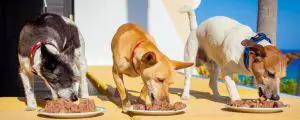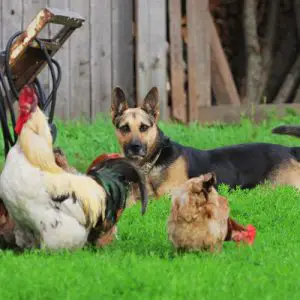Rather than punishing your dog for bad behavior, positive reinforcement is the most effective method of training and rewarding your dog for doing the right thing.
In this guide, we explain how you can use positive reinforcement to reward your dog for a job well done!
Types Of Rewards
Positive reinforcement includes several kinds of rewards, typically:
- Food treats
- Petting
- Verbal praise
- A favorite game or toy
Most dog owners find that using food treats is the most effective training reward.
The treat you decide to use must be tempting and irresistible to your dog. Food treats should be very small, soft, and easy to eat rather than a large lump of food that crumbles and falls onto the floor or needs your dog to chew it.
We recommend using a variety of treats so that your dog doesn’t get bored by receiving the same reward every time. You should use a verbal praise reward when you give your dog a treat. Say something like “good boy” or “yes” enthusiastically. Then present your dog with a food treat.
Not all dogs are motivated by food, so you might find using a toy, a brief play session, or petting your dog is more effective.
When To Use Treat Rewards
Whenever your dog is learning something new, you must reward him whenever he demonstrates that behavior. That’s referred to as continuous reinforcement. You should switch to intermittent reinforcement when your dog has learned that behavior.
To begin with, give your dog a treat four out of five times he exhibits the behavior you want. Gradually reduce that until you only reward your dog occasionally.
Be careful not to stop rewarding your dog too quickly, as your dog will become frustrated and confused. Keep praising your dog every time, tempering your tone of voice once your pet has learned the behavior.
It’s important to vary the reward frequency so that the dog doesn’t work out that he only needs to respond every other time. You want the dog to respond every time you ask him for the behavior until receives the reward he craves.
Positive reinforcement doesn’t mean that you always have to carry a bag of treats. Your dog will quickly learn to work for your verbal praise, partly because he wants to please you but also because he knows he’ll occasionally receive a treat too.
Timing
The most important aspect of positive reinforcement training is timing.
When you reward your dog for doing the right thing, that reward must happen immediately within milliseconds of the desired behavior. Dogs live in the moment, and if the reward comes too late, your dog won’t associate it with the good behavior he’s shown.
For example, if you ask your dog to go into his crate but reward him when he comes back out again, your pup will think he’s being rewarded for leaving the crate rather than going into it.
Short and Sweet
When using positive reinforcement methods, you need to keep your commands short and easy for your dog to understand and remember.
In fact, your dog learns more from your body language than from your words. So, if you want to teach your dog to “sit,” hold a treat or a toy in your hand. Pass your hand over and slightly above your dog’s head so that he has to sit down to look up and see the treat or toy. As soon as the dog sits, praise him verbally and give him the treat.
Once your pet sits consistently, begin using the word “sit” calmly and once only. Soon, your dog will sit down when given the verbal command alone.
Be Consistent
If several family members are helping to train your dog, make sure that each person uses the same verbal cue; otherwise, your dog will become confused. It can sometimes be helpful to post a list of verbal commands somewhere where everyone in your family can see it.
You must also be consistent in the way that you reward your dog’s desired behavior and be sure never to reward bad behavior.
When Should You Use Positive Reinforcement?
Positive reinforcement training is an excellent way to teach your dog cues and reinforce good behavior.
For example, you might want to teach your dog to sit:
- Before letting them outside to help prevent door-barging
- Before petting your dog to prevent him from jumping up at people
- Before feeding your dog to teach him good manners at mealtimes
When your dog is resting quietly on his bed, you should pet him and tell him he’s a “good dog,” positively reinforcing his good behavior.
Don’t Positively Reinforce Unwanted Behaviors
Take care not to accidentally reinforce unwanted behaviors.
For example, if your dog starts barking at something outside, don’t let him out. That reinforces the undesirable behavior by giving your dog access to the yard, which he will see as a reward.
Begging
So, will using food treats as a reward encourage a dog to beg for food?
Essentially, that comes down to context. For example, if you give your dog tidbits from the table, he will always hang around whenever you’re eating, hoping for food. However, if you only use treats for training your dog, he’ll quickly realize that he’s working for the reward and not just for a handout.
Final Thoughts
Positive reinforcement training is the preferred method of teaching your dog desired behaviors and rewarding him for a job well done.
Choose short, clear verbal commands to use alongside physical cues, and have a supply of treats or a toy on hand with which to reward your dog. Reward your dog immediately if he shows the desired behavior with a treat and verbal praise. Be consistent in your approach, and you will ultimately have a well-behaved, happy canine companion to share your life with.



